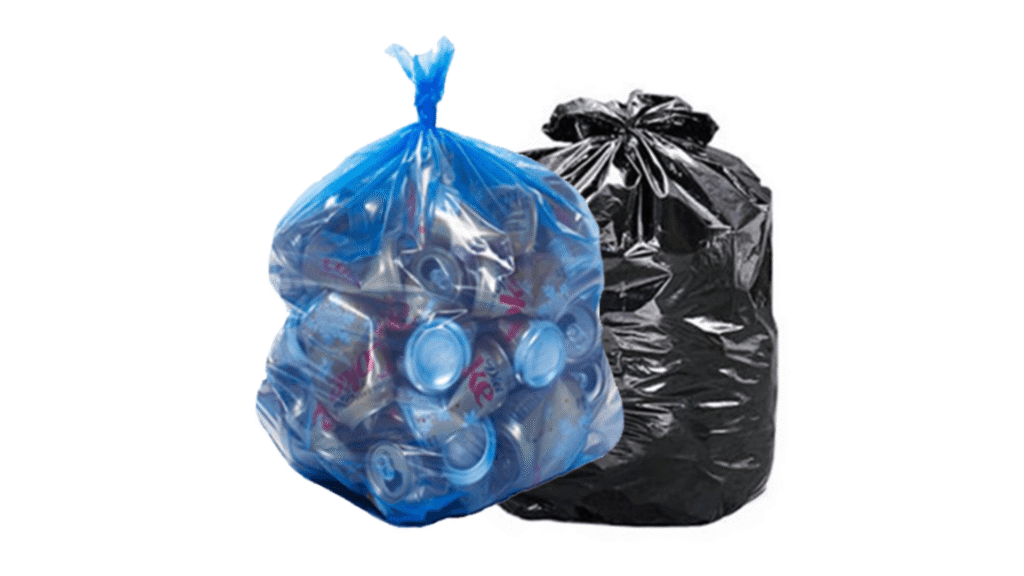The proper disposal of kitchen waste can be a concern if not handled properly.
Whether it is leftover food, grease, packaging waste, or broken or contaminated items, kitchen waste causes issues like creating odors, attracting pests, and adding to environmental problems like landfills overflowing with waste.
Therefore, kitchen waste disposal should be one of the top priorities for all organizations, whether it is a hotel, hospital, or school.
It affects your bottom line and overall productivity if not managed properly. Of course, you must have trash bags in place to manage your waste. However, not everyone is aware of the right size of the trash bag. Choosing the wrong one can lead to spills, wasted time, money, and inefficiencies.
By learning how trash bag sizes work, you can save time, reduce waste, and focus on core functions in the kitchen.
Why Trash Bag Size is Important in Business
In a commercial setting, disposal needs are much greater than they are in a home kitchen. A household-standard kitchen trash bag may be too small for a restaurant’s back-of-house kitchen, while an oversized variety may result in unnecessary costs or bags that don’t fit properly.
A wrong bag can slip into the bin. Also, it is vulnerable to tearing. Maybe it leaves gaps, causing spills and hygiene problems.
And when it comes to industries such as catering, healthcare, or manufacturing, the decision of using kitchen bags also impacts compliance with hygiene regulations. Therefore, consider the right garbage bag dimensions. It gives you peace of mind that the bins are properly lined and sealed. This way, it lowers the risk of cross-contamination and odors.
Understanding Kitchen Trash Bag Sizes
Not every trash bin is the same. Therefore, it is important to know the right trash bag sizes for bins used in your facility. You can refer to a trash bag size chart to know what size bag can fit your bins.
Kitchen trash bags are generally measured in liters or gallons. However, these measurements can be misleading without considering bin dimensions. For instance, two bins labeled as 13-gallon containers might slightly vary in height and width. In such a scenario, an organization can feel the need for a custom trash bag size.
To handle large commercial waste, the standard “13-gallon kitchen bag” may be insufficient.
Commercial garbage cans vary in size, and their capacities are listed as something heavier. When it comes to selecting the right trash bags, start by measuring your trash can.
The two most important measurements you’ll need to know are the circumference of the can and the height.
Circumference:
To make the trash bag fit over the lip of the can so that it does not slide down, the bag has to be at least as wide as half the circumference of the can. A rule of thumb is to add a couple of inches, just allowing for some overlap and tie-off space.
So, the equation is:
Bag Width = (Can Circumference / 2) + a few inches overage for a tie off.
Height:
The bag should be taller than the bin so that the liner does not sink, and there is enough material to tie at the top securely.
The equation for this is:
Bag Height = Can Height + (Can Diameter / 2) + a little bit extra for overlap/tie-off. The “Can Diameter / 2” section takes into account the bag hanging halfway down inside the can.
Even making a near-perfect measurement using these equations is better than guesswork to make an informed decision.
The Problem of Choosing a One Size Fits All Bag
Too Small:
An undersized bag will be stretched beyond its limits, resulting in a torn bag and a mess of trash. This creates expensive clean-ups, product waste, and health and safety hazards. Staff will also spend additional time double-bagging or coping with bags that have split, which is a productivity drainer.
Too Big:
Conversely, using a bag that is too big is a direct waste of money. You are paying for extra material that is useless. This is a problem with the big-galled 55-gallon bags in 44-gallon cans. That extra plastic just ends up balled up, at a higher cost per use and a heavier environmental footprint.
The optimal method for a business is to invest in several different sizes of trash bags that match the bins in use. For example, a restaurant might use 33-gallon bags for the main kitchen trash cans, 10-gallon bags for smaller prep-areas, and 55-gallon bags for the trash can outside.
The Role of Bag Type and Material in a Commercial Kitchen
Getting the correct size is only half the battle.
The material and type of trash bag matter just as much, depending on the type of waste.
High-Density Polyethylene (HDPE):
They are used for light, larger things such as dry garbage, plastic wrappers, and paper. These bags are thin yet quite strong and have good tensile strength. But they’re not as durable against punctures and tears caused by sharp objects, and are not well-suited for kitchens that generate a lot of food scraps with bones or container edges.
Low-Density Polyethylene (LDPE):
LDPE bags are stronger and puncture-resistant.
They are more opaque, thicker, and stretchy, making them an ideal choice for the majority of commercial kitchens.
They don’t tear when filled with food scraps, broken glass, and other sharp objects.
Linear Low-Density Polyethylene (LLDPE):
It is a stronger stretching version of LDPE. They are used by organizations dealing with heavy or dense waste.
Understanding the Thickness Factor
For B2B use, the bag’s thickness, or “mil” thickness, is an important measurement. The higher the mil, the thicker and more durable the bag. If your home office needs a standard 0.7 mil bag, a commercial kitchen dealing with food scraps and other heavy items should choose a bag of 1.5 mil or more to avoid tears.
Educate Your Staff on Using Kitchen Trash Bags
Your staff have to be trained on which bags to use for which bin. A simple color-coded system or even clear labels on the supply shelves can help to ensure employees do not use the wrong size, resulting in product waste.
The Bottom Line:
While investing in the right kitchen trash bag may not be a necessity for some businesses, it can lead to significant savings and uninterrupted operations in the long run. Otherwise, choosing a bag that is too small or too large can lead to plenty of issues, including spills, odors, wasted time and money, ultimately impacting your bottom line.
Simple practices like measuring your bins, understanding the thickness of trash bags, and the material of the bag can help you choose the right size of kitchen trash bag for your organization. It’s an investment for a clean, efficient, smart, sustainable business.





